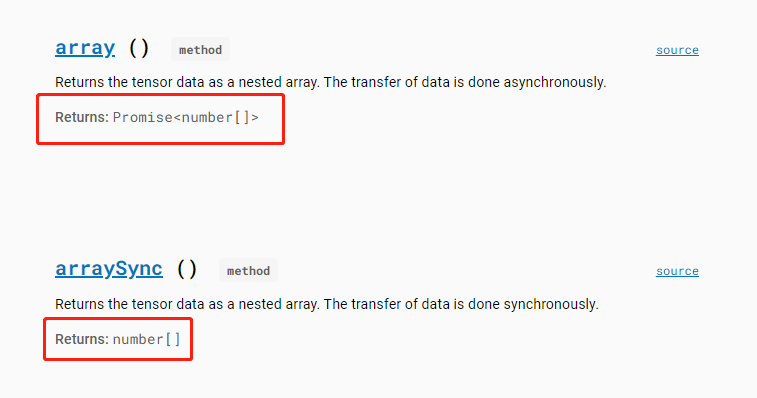从 Numpy+Pytorch 到 TensorFlow JS:总结和常用平替整理
demo展示

这是一个剪刀石头布预测模型,会根据最近20局的历史数据训练模型,神经网络输入为最近2局的历史数据。
如何拥有较为平滑的移植体验?
- 保持两种语言,和两个框架的API文档处于打开状态,并随时查阅:Python,JavaScript;Pytorch,TensorFlow JS(用浏览器 F3 搜索关键词)。
- 可选阅读,《动手学深度学习》,掌握解决常见学习问题时,Pytorch 和 TensorFlow 的实现方法。
- 精读 TensorFlow JS 的官方教程,和指南。
- 精读 TensorFlow JS 的官方文档:与 Python tf.keras 的区别。
- 深入了解 JavaScript 特色对象:生成器 Generator,Promise,async await。
一些碎碎念
- JavaScript 不存在像 numpy 之于 python 一样著名且好用的数据处理库,所以请放弃对 JavaScript 原生类型 Array 进行操作的尝试,转而寻找基于 TensorFlow JS API 的解决方法。
- JavaScript 作为一门前端语言,一大特色是包含了大量异步编程(即代码不是顺序执行的,浏览器自有一套标准去调整代码的执行顺序),这是为了保证前端页面不被卡死,所必备的性质。也因此,TensorFlow JS的函数中,许多输入输出传递的都不是数据,而是Promise对象。很多功能支持异步,但如果没有完全搞懂异步编程,不妨多用同步的思路:用 tf.Tensor.arraySync() 把 Tensor 的值取出,具体来说是将 Tensor 对象以同步的方式(即立即执行)拷贝生成出一个新的 array 对象。
- Promise 对象是ES6新增的对象,一般与then一起使用,但掌握 async & await 就够了,这是更简洁的写法。
- 多关注 API 文档中对象方法的返回类型,返回 Promise 对象则与异步编程相关,如果要获取Promise对象储存的值,需要在有 async function 包裹的代码中前置 await 关键字。

- Pytorch 中的张量可以通过索引访问其元素,而 TensorFlow JS 则不能,需要转换为 array 进行访问。
常用平替整理
将张量转换为数组
- Python, Pytorch:
tensor = torch.tensor([1,2,3])
np_array = tensor.numpy()
- JS, tfjs:
// 方式一:arraySync() let tensor = tf.tensor1d([1,2,3]); let array = tensor.arraySync(); console.log(array); // [1,2,3] // 方式二:在async函数体内操作 async function fun() { let tensor = tf.tensor1d([1,2,3]); let array = await tensor.array(); console.log(array); // [1,2,3] } fun(); // 注意,下面的写法是不行的,因为async函数的返回值是Promise对象 array = async function (){ return await tensor.array(); }(); console.log(array); // Promise object // 方式三:用then取出async函数返回Promise对象中的值 let a (async function() { let array = await tensor.array(); return array })().then(data => {a = data;}) console.log(a); // [1,2,3]
访问张量中的元素
- Python,Pytorch:
tensor = torch.tensor([1,2,3]) print(tensor[0]) print(tensor[-1])
- JS,tfjs(不能直接通过访问tensor,需要转换成array):
const tensor = tf.tensor1d([1,2,3]); const array = tensor.arraySync(); console.log(array[0]);
console.log(array[array.length - 1]);
获取字典/对象的关键字
- Python:
actions = {'up':[1,0,0,0], 'down':[0,1,0,0], 'left':[0,0,1,0], 'right':[0,0,0,1]}
actions_keys_list = list(actions.keys())
- JS:
const actions = {'up':[1,0,0,0], 'down':[0,1,0,0], 'left':[0,0,1,0], 'right':[0,0,0,1]};
const actionsKeysArray = Object.keys(actions);
“先进先出”栈
- Python:
memory = [1,2,3] memory.append(4) # 入栈 memory.pop(0) # 出栈
- JS:
let memory = [1,2,3]; memory.push(4); // 入栈 memory.splice(0,1); // 出栈
“后进先出”栈
- Python:
memory = [1,2,3] memory.append(4) # 入栈 memory.pop() # 出栈
- JS:
let memory = [1,2,3]; memory.push(4); // 入栈 memory.pop(); // 出栈
根据概率分布采样元素
- Python,Numpy:
actions = ['up','down','left','right'] prob = [0.1, 0.4, 0.4, 0.1] sample_action = np.random.choice(actions, p=prob))
- JS,tfjs:
const actions = ['up', 'down', 'left', 'right']; const prob = [0.1, 0.4, 0.4, 0.1]; sampleActionIndex = tf.multinomial(prob, 1, null, true).arraySync(); // tf.Tensor 不能作为索引,需要用 arraySync() 同步地传输为 array sampleAction = actions[sampleActionIndex];
找到数组中最大值的索引(Argmax)
- Python,Numpy,Pyorch:
actions = ['up', 'down', 'left', 'right'] prob = [0.1, 0.3, 0.5, 0.1] prob_tensor = torch.tensor(prob) action_max_prob = actions[np.array(prob).argmax()] # np.array 可以作为索引 action_max_prob = actions[prob_tensor.argmax().numpy()] # torch.tensor 不能作为索引,需要转换为 np.array
- JS, tfjs:
const actions = ['up', 'down', 'left', 'right']; const prob = [0.1, 0.3, 0.5, 0.1]; const probTensor = tf.tensor1d(prob); const actionsMaxProb = actions[probTensor.argmax().arraySync()]; // tf.Tensor 不能作为索引,需要用 arraySync()同步地传输为 array
生成等差数列数组
- Python:
range_list = list(range(1,10,1))
- JS, tfjs:
const rangeArray = tf.range(1, 10, 1).arraySync();
打乱数组
- Python:
actions = ['up', 'down', 'left', 'right'] print(random.shuffle(actions))
- JS:How to randomize (shuffle) a JavaScript array? 关于原生JS解决方案的大讨论。
- tfjs:(1)用 tf.util 类操作,处理常规的需求。
const actions = ['up', 'down', 'left', 'right'];
tf.util.shuffle(actions);
console.log(actions);
(2)用 tf.data.shuffle 操作,不建议,该类及其方法一般仅与 神经网络模型更新 绑定使用。
极简逻辑回归
- Python,Numpy,Pytorch:
import numpy as np import torch from torch import nn import random class Memory(object): # 向Memory输送的数据可以是list,也可以是np.array def __init__(self, size=100, batch_size=32): self.memory_size = size self.batch_size = batch_size self.main = [] def save(self, data): if len(self.main) == self.memory_size: self.main.pop(0) self.main.append(data) def sample(self): samples = random.sample(self.main, self.batch_size) return map(np.array, zip(*samples)) class Model(object): # Model中所有方法的输入和返回都是np.array def __init__(self, lr=0.01, device=None): self.LR = lr self.device = torch.device("cuda:0" if torch.cuda.is_available() else "cpu") # 调用GPU 若无则CPU self.network = nn.Sequential(nn.Flatten(), nn.Linear(10, 32), nn.ReLU(), nn.Linear(32, 5), nn.Softmax(dim=1)).to(self.device) self.loss = nn.CrossEntropyLoss(reduction='mean') self.optimizer = torch.optim.Adam(self.network.parameters(), lr=self.LR) def predict_nograd(self, _input): with torch.no_grad(): _input = np.expand_dims(_input, axis=0) _input = torch.from_numpy(_input).float().to(self.device) _output = self.network(_input).cpu().numpy() _output = np.squeeze(_output) return _output def update(self, input_batch, target_batch): # 设置为训练模式 self.network.train() _input_batch = torch.from_numpy(input_batch).float().to(self.device) _target_batch = torch.from_numpy(target_batch).float().to(self.device) self.optimizer.zero_grad() _evaluate_batch = self.network(_input_batch) batch_loss = self.loss(_evaluate_batch, _target_batch) batch_loss.backward() self.optimizer.step() batch_loss = batch_loss.item() # 设置为预测模式 self.network.eval() if __name__ == '__main__': memory = Memory() model = Model() # 产生数据并输送到内存中 # 假设一个5分类问题 for i in range(memory.memory_size): example = np.random.randint(0,2,size=10) label = np.eye(5)[np.random.randint(0,5)] data = [example, label] memory.save(data) # 训练100次,每次从内存中随机抽取一个batch的数据 for i in range(100): input_batch, target_batch = memory.sample() model.update(input_batch, target_batch) # 预测 prediction = model.predict_nograd(np.random.randint(0,2,size=10)) print(prediction)
- JS,tfjs(网页应用一般不使用GPU):
const Memory = { memorySize : 100, main : [], saveData : function (data) { // data = [input:array, label:array] if (this.main.length == this.memorySize) { this.main.splice(0,1); } this.main.push(data); }, getMemoryTensor: function () { let inputArray = [], labelArray = []; for (let i = 0; i < this.main.length; i++) { inputArray.push(this.main[i][0]) labelArray.push(this.main[i][1]) } return { inputBatch: tf.tensor2d(inputArray), labelBatch: tf.tensor2d(labelArray) } } } const Model = { batchSize: 32, epoch: 200, network: tf.sequential({ layers: [ tf.layers.dense({inputShape: [10], units: 16, activation: 'relu'}), tf.layers.dense({units: 5, activation: 'softmax'}), ] }), compile: function () { this.network.compile({ optimizer: tf.train.sgd(0.1), shuffle: true, loss: 'categoricalCrossentropy', metrics: ['accuracy'] }); }, predict: function (input) { // input = array // Return tensor1d return this.network.predict(tf.tensor2d([input])).squeeze(); }, update: async function (inputBatch, labelBatch) { // inputBatch = tf.tensor2d(memorySize × 10) // labelBatch = tf.tensor2d(memorySize × 5) this.compile(); await this.network.fit(inputBatch, labelBatch, { epochs: this.epoch, batchSize: this.batchSize }).then(info => { console.log('Final accuracy', info.history.acc); }); } } // 假设一个5分类问题 // 随机生成样例和标签,并填满内存 let example, label, rnd, data; for (let i = 0; i < Memory.memorySize; i++) { example = tf.multinomial(tf.tensor1d([.5, .5]), 10).arraySync(); rnd = Math.floor(Math.random()*5); label = tf.oneHot(tf.tensor1d([rnd], 'int32'), 5).squeeze().arraySync(); data = [example, label]; Memory.saveData(data); } // 将内存中储存的数据导出为tensor,并训练模型 let {inputBatch, labelBatch} = Memory.getMemoryTensor(); Model.update(inputBatch, labelBatch);




【推荐】国内首个AI IDE,深度理解中文开发场景,立即下载体验Trae
【推荐】编程新体验,更懂你的AI,立即体验豆包MarsCode编程助手
【推荐】抖音旗下AI助手豆包,你的智能百科全书,全免费不限次数
【推荐】轻量又高性能的 SSH 工具 IShell:AI 加持,快人一步